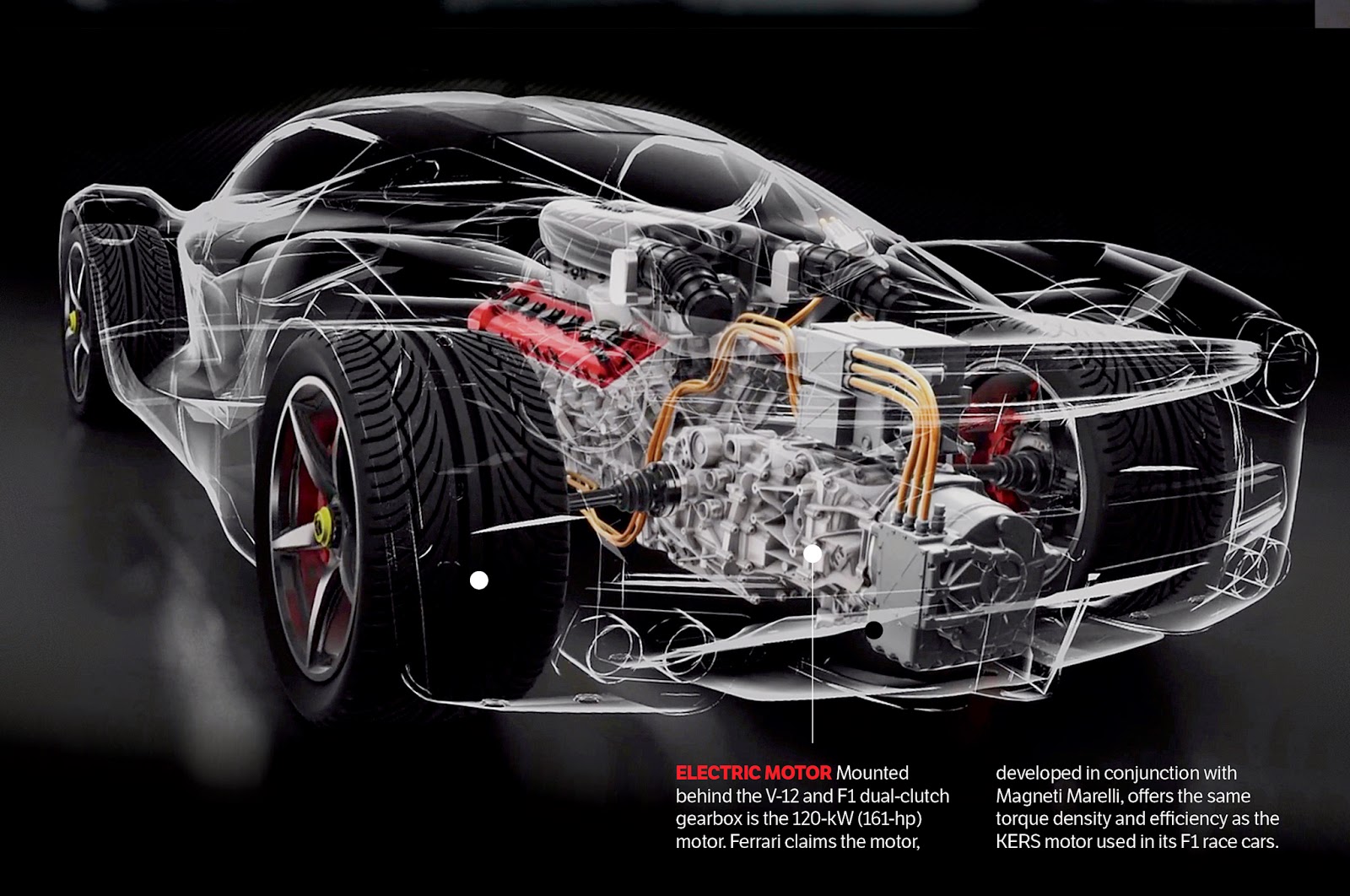The LaFerrari is very possibly the world’s fastest, most exciting hypercar.
The bottom line, however, is that LaFerrari has more power (a whopping 950bhp) and less weight to carry around than its prestigious rivals so figuratively, if nothing else, it quite clearly has the upper hand.
Either way, this is the ultimateFerrari, and it has but four ancestors; the 288 GTO, the F40, the F50 and the Enzo, each of these being a limited series car, just like LaFerrari, of which just 499 will be made during the next two years.
At the centre of the car, behind its two fixed carbonfibre seats, sits a 6262cc naturally aspirated V12 engine that generates 790bhp at 9000rpm and 516lb ft of torque at 6750rpm. On their own these outputs would be sufficient to make LaFerrari more potent than the Scuderia’s last V12 F1 car, the 412T from 1995.
 But also behind and beneath the seats sits a 60kg lithium ion battery pack which, via a 25.7kg electric motor, provides a further 160bhp and 199lb ft to give combined outputs of 950bhp and 715lb ft.
But also behind and beneath the seats sits a 60kg lithium ion battery pack which, via a 25.7kg electric motor, provides a further 160bhp and 199lb ft to give combined outputs of 950bhp and 715lb ft.
However, entirely unlike its rivals from Porsche and McLaren, the Ferrari’s power unit has been designed to produce its maximum outputs all of the time. There is no e-mode that can be engaged as such. Instead, the combustion engine and the Hy-KERS system have been engineered to work as one, with energy being constantly harvested on the move (via the brakes, the ABS system, the traction control system and even the E-Diff) to deliver full beans, as in 950bhp, whenever you want it.
The prodigious energy produced by this so-called power unit is then sent to the rear wheels, and the rear wheels only, via a seven-speed dual clutch auto gearbox, made for Ferrari by Getrag. This also has an electric motor attached to it, with a dedicated gear-set that transmits drive directly to the final drive, thereby reducing the need for a typically vast clutch. The meticulous removal of weight runs as a key theme throughout the supercar's engineering, and this is but one example.
As with the P1 and 918, LaFerrari features a carbonfibre tub on to which the engine and suspension are mounted. At each corner there are double wishbones (carbonfibre at the front) and coil springs with electronically controlled dampers, plus an enormous carbon-ceramic disc brake made by Brembo, those at the front measuring 398mm, those at the rear 380mm.
Electronics play a huge role in the car's engineering, and in the delivery of its vast dynamic repertoire. Wings at the front and rear are actively deployed on the move to provide two radically different running configurations; high and low downforce modes.
Ferrari claims the driving position is half way between that of a normal sports car and a Formula 1 car, with the driver’s backside sitting at broadly the same height as their toes. Sit on the floor against a wall with your arms and legs out-stretched but slightly bent, holding on to an imaginary steering wheel, then shift your bum forwards so that your back is at an angle of 32 degrees to the wall and you’ll get a rough idea of how “single-seater” the driving position feels. And the rest of the cabin is very much in the same vein.
There are three different instrument styles than can be dialled up within the TFT digital dash display, all with the rev counter dominating to varying degrees. Anyone who’s ever been fortunate enough to sit in a458 will recognise certain elements immediately, but there’s a sense of purity inside the Ferrari that elevates it above any of Maranello’s other cars. It feels quite a lot like you’re sitting inside a very well appointed Le Mans car, actually, with swathes of Alcantara and buttons for the sat-nav where normally you might expect to find switches marked 'rain' or 'pit lane speed limiter'.
However fast and furious and noisy and exciting to drive you might imagine LaFerrari to be, double it, add 20 and you might, just maybe, get somewhere close.
The ride instantly feels spookily smooth and calm, the steering surprisingly light but bursting with a delicious, old school kind of feel. The brake pedal also feels light underfoot but is again rippling with feel. And the throttle response, the first time I go anywhere near the loud pedal is just outrageous; the car explodes down the back straight even on half throttle in fourth gear.
Ferrari LaFerrari specifications
Price €1.2m (approx £1.15 million); 0-62mph Sub-3.0sec (claimed);
Economy na; CO2 333g/km;
Kerb weight 1255kg (dry), 1345kg (approx) with fluids;
Engine V12, 6262cc, petrol plus electric motors;
Installation Mid, longitudinal, rear wheel drive;
Power 950bhp at 9000rpm; Torque 715lb ft at 6750rpm; Power to weight 707bhp/tonne (with fluids); Specific output 152bhp/litre;Compression ratio 13.5.0:1;
Gearbox 7-speed paddle shift DCT;
Length 4702mm; Width 1992mm; Height 1116mm; Wheelbase2650mm; Fuel tank n/a; Range n/a; Boot n/a;
Front suspensionDouble wishbones, coil springs, anti-roll bar, electronic adaptive dampers; Rear suspension double wishbones, coil springs, anti-roll bar, electronic adaptive dampers;
Brakes 398/380mm, ventilated carbon ceramic discs, front and rear;
Wheels 9.5jx19in (front), 13.0jx20in (rear); Tyres 265/30 ZR19 front, 345/30 ZR 20 rear, Pirelli P-Zero Corsa
LaFerrari is a more than worthy successor to the Enzo. Indeed, it makes the old-timer feel gruesomely under-achieving in most respects, and is also a much easier, far sweeter car to drive in the process.
Be in no doubt; LaFerrari is a true masterpiece from Maranello.





No comments:
Post a Comment